Background:
A hernia occurs when an organ or fatty tissue squeezes through a weak spot in a surrounding muscle or connective tissue called fascia. Hernias are caused by a combination of muscle weakness and strain, depending on its cause, a hernia can develop quickly or over a long period of time.
https://www.youtube.com/watch?v=LfwymP91S7A – Overview of Hernia and procedure
Symptoms:
The most common symptom of a hernia is a bulge or lump in the affected area. A person is more likely to feel a hernia through touch when standing up. The symptoms of an inguinal hernia are pain and discomfort in the affected area especially when bending over, coughing or lifting. Weakness, pressure, or a feeling of heaviness in the abdomen. A burning, gurgling, or aching sensation at the site of the bulge.
Types of Hernias:

Hiatal Hernia: Occur from a weakness or opening in the diaphragm, the muscle that separates the chest cavity from the abdominal cavity
Three Methods for Hernia Repair:
There are three major methods that surgeons use to repair hernias. One method is tension repair. In this procedure, the surgeon makes an incision in the abdomen above the hernia site and pushes any protruding tissue back into the correct location and then stitches the incision closed. This method, however, has a high rate of occurrence, especially with ventral and inguinal type hernias.
- A second type of repair is tension-free repair. This method uses a piece of mesh to bridge the hernia defect as opposed to sewing the two sides together. This is the most common hernia repair technique.
- The last type of repair is laparoscopic tension free repair,
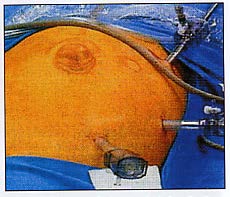 where the surgeon makes 3-4 small incisions in the abdominal wall and inserts a small tube where instruments and a small video camera can be put. Mesh is also used in this method to be put over the weakened area. This method is different though, in the fact that the hernia is being repaired from behind the abdominal wall whereas in other types, the mesh is placed on the outside of the abdominal wall.
where the surgeon makes 3-4 small incisions in the abdominal wall and inserts a small tube where instruments and a small video camera can be put. Mesh is also used in this method to be put over the weakened area. This method is different though, in the fact that the hernia is being repaired from behind the abdominal wall whereas in other types, the mesh is placed on the outside of the abdominal wall.
Composite Mesh for Hernia Repair:
Hernias have a high rate of recurrence,
and surgeons  often use surgical mesh to strengthen the hernia repair and reduce the rate of recurrence. Surgical mesh is a medical device that is used to provide additional support to weakened or damaged tissue. A composite mesh in particular is a mesh that has differing properties on the visceral and parietal sides. You want the mesh to support the hernia and wall without adhering to organs. There are two kinds of surgical mesh, absorbable and non-absorbable. Non-absorbable mesh will remain in the body indefinitely and is considered a permanent implant. It is used to provide permanent reinforcement to repaired hernia. Absorbable meshes will degrade and lose strength over time.
often use surgical mesh to strengthen the hernia repair and reduce the rate of recurrence. Surgical mesh is a medical device that is used to provide additional support to weakened or damaged tissue. A composite mesh in particular is a mesh that has differing properties on the visceral and parietal sides. You want the mesh to support the hernia and wall without adhering to organs. There are two kinds of surgical mesh, absorbable and non-absorbable. Non-absorbable mesh will remain in the body indefinitely and is considered a permanent implant. It is used to provide permanent reinforcement to repaired hernia. Absorbable meshes will degrade and lose strength over time.
It is not intended to provide long-term
reinforcement to the repair site.
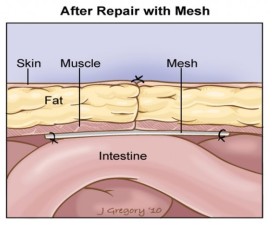
As the material degrades, new tissue growth is intended to provide strength to the repair. Mesh fibers can be monofilament, multifilament, or patches. Multifilament fibers have a higher risk of infection. The use of surgical mesh may also improve patient outcomes through decreased operative time and minimized recovery time, though recovery time depends on the type of hernia, the surgical approach, and the patient’s condition before and after surgery.
Since the 2000’s non-mesh repairs represented less than 10% of groin hernia repair techniques.
What is the mesh made of?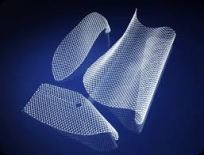
Surgeons typically use a sterile, woven or knitted material made from polypropylene or polyester. The mesh needs to be strong and sturdy, but also soft, flexible, and thin. The mesh can be cut to size depending on the site that it is being used.
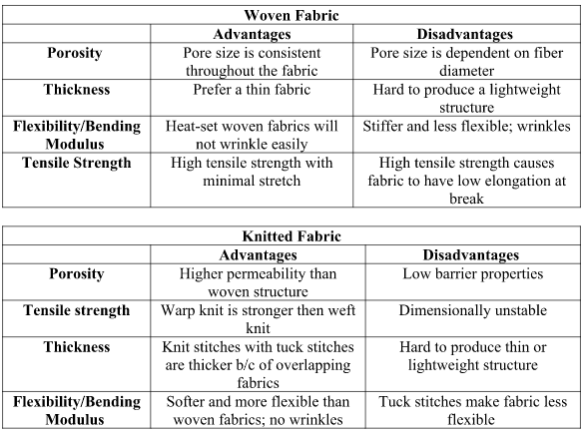
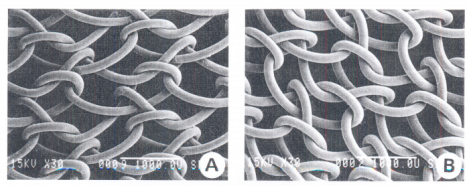
The figure above shows a close up image of a knitted polypropylene mesh fabric. This is a single bar warp knitted structure with Atlas lapping. A is Marlex, made by Bard; B is Trelex, made my Ethicon.
Composite Mesh vs Monofilament Mesh:
Composite mesh differs from monofilament mesh in that they combine more than one material into the mesh instead of just using one material. The advantage of a composite mesh is that they can be used in the intraperitoneal space (injection space) with minimal adhesion formation. The visceral side has a micro porous surface to prevent visceral adhesions, whereas the non-visceral side is often macro porous to allow parietal tissue ingrowth. Most of them are composed of either PP, POL or ePTFE and combined with each other or with other materials such as titanium, omega3, or monocryl.
Sterilization Techniques:
There are many different ways to sterilize hernia meshes. One of the most common sterilization methods used for hernia meshes is gamma sterilization. When a mesh undergoes gamma sterilization, it is exposed to a cobalt 60 source for a 2.5 Mrad dose. Since this sterilization method doesn’t work for all polymers, there are alternative methods that can be used such as steam and ethylene oxide however these methods are polymer restricted. Polypropylene, polyglycolic acid and polyglactin are advised to be sterilized with ethylene oxide which is quick but requires a lot of aeration time for safety.
Advantages of Gamma Sterilization:
- Reliable process
- No residue is left after the gamma sterilization process
- Not an expensive process
- Complete penetration of the product
Disadvantages of Gamma Sterilization:
- Not environmentally safe
- Discoloration may occur
- Does not work on all materials
- Product needs to be quarantined for up to two weeks
![]()
Ethicon is a subsidiary of Johnson + Johnson. They focus on manufacturing surgical sutures as well as would closure devices. They have a wide range of Hernia Repair & Fixation products that they divide into five categories: Hernia Fixation, Hernia Mesh – Flat Mesh, Hernia Mesh – Tissue Separating Mesh, Hernia Mesh – Biological Mesh, and Hernia Mesh Devices. Ethicon aligns each of their products with each stage of the hernia mesh repair procedure with the following:
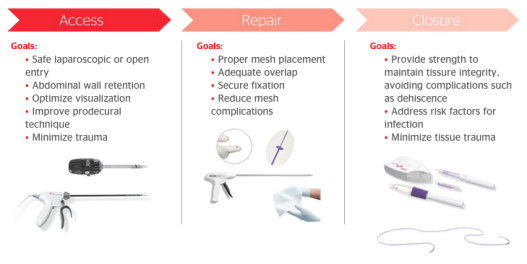
Ethicon Physiomeshis a flexible composite mesh that Ethicon has trademarked. The film using Monocryl Suture polymer minimizes visceral attachments to the mesh, thus potentially reducing the risk factors associated with patient complications. This mesh is also been proven to deliver a strong and durable repair with low recurrence rate up to one year post surgery.
Company Hernia Repair Website: http://www.ethicon.com/healthcare-professionals/products/hernia-repair-and-fixation
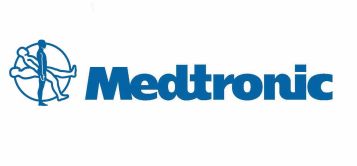
Medtronic is a medical device company, as well as the world’s largest standalone medical technology development company. In 2014, Medtronic acquired Covidien, the largest acquisition in its history. Most of Medtronics hernia mesh products are Covidien’s original products, so they are labeled ‘Medtronic – Covidien.’ They claim that ‘Innovation meets performance’ in their line of synthetic mesh for hernia surgery. They carry approximately 15 different types of hernia meshes that specify in detail what type of hernia the product is best to treat. Most products include product brochures, clinical data, and information sheets, while a couple of the products also include procedural videos, all located on the Medtronic website.
Company Hernia Mesh Products Website: http://www.medtronic.com/covidien/products/hernia-repair/mesh-products

For the past 40 years, Bard Davol has stood out as the market leader in providing solutions in soft tissue reconstruction, including products for hernia repair. They have a growing line of mesh prosthetics and innovative techniques for inguinal, ventral, and other hernia procedures. They have a wide range of products that vary in size, shape, material, and flexibility according to where the mesh is being used.
One product that Bard has trademarked is Composix™ L/P mesh. The parietal side of the Composix™ L/P Mesh features large pore, lightweight polypropylene Bard Soft Mesh which encourages rapid tissue ingrowth for a strong repair while leaving less foreign material in the body. The visceral side features Bard submicronic permanent ePTFE barrier. The ePTFE barrier helps minimize tissue attachment to the prosthesis and the monofilament polypropylene mesh provides fast tissue ingrowth and incorporation.
Company Hernia Repair & Fixation Products Website: http://www.davol.com/products/hernia-repair-fixation/
**FINAL VERSION**
References:
[1] Wedro, Benjamin. Hernia (Abdominal Hernia). MedicineNet.com. Last Reviewed: Feb 2, 2016. http://www.medicinenet.com/hernia_overview/article.htm
[2] Ratini, Melinda. Understanding Hernia – The Basics. WebMD. Last Reviewed: Mar 22, 2015. http://www.webmd.com/digestive-disorders/understanding-hernia-basics
[3] Rutkow, I.M. (2003). Demographic and Socieconomic Aspects of Hernia Repair in the United States in 2003. Surgical Clinics of North America; 83(5):1045-51, v-vi. http://www.fda.gov/MedicalDevices/ProductsandMedicalProcedures/ImplantsandProsthetics/HerniaSurgicalMesh
[4] Reinberg, Steve. Mesh For Hernia Repair Reduces Recurrence: Study. WebMD. Feb 19, 2014. http://www.webmd.com/digestive-disorders/news/20140219/mesh-for-hernia-repair-reduces-recurrence-study-suggests
[5] Mesh and Hernia Repair. Ethicon Hernia Solutions. https://www.herniasolutions.com/mesh-hernia-repair
[6] Types of Hernia Surgeries. Dartmouth-Hitchcock. http://www.dartmouth-hitchcock.org/hernia/types_of_hernia_surgeries.html
[7] Kapoor, Vinay. Open Inguinal Hernia Repair MedScape. Aug 5, 2015. http://emedicine.medscape.com/article/1534281-overview
[8] Swierzewski, Stanley III. Hernia Repair Overview, Types of Hernia Repair Surgery. Remedy’s Health.com Communities. Sep 18, 2015. http://www.healthcommunities.com/hernia-repair/overview-types-hernia-repair.shtml
[9] Martin, Jerold. Understanding Gamma Sterilization. BioPharm International. Volume 25 Issue 2. Feb 1, 2012. http://www.biopharminternational.com/understanding-gamma-sterilization
[10] Schwarz, Markus; Gundling, Ralf; Kai, Nowak; Hohenberger, Peter; Roessner, Eric; Plott, Peter. Mechanical Properties of Mesh Materials Used for Hernia Repair and Soft Tissue Augmentation. PLOSone. Oct 12, 2012. http://journals.plos.org/plosone/article?id=10.1371/journal.pone.0046978
[11] Bilsel, Yilmaz; Abci, Ilker. The search for ideal hernia repair; mesh materials and types. ScienceDirect. http://www.sciencedirect.com/science/article/pii/S1743919112000921
[12] Hernia Repair & Fixation. Ethicon. http://www.ethicon.com/healthcare-professionals/products/hernia-repair-and-fixation
[13] Hernia Repair Mesh Products. Medtronic. http://www.medtronic.com/covidien/products/hernia-repair/mesh-products
[14] Hernia Repair Products. Bard Davol, Inc. http://www.davol.com/products/hernia-repair-fixation/
[15] Tran, H., Saliba, L., Chandratnam, E., Turingan, I., & Hawthorne, W. (2012). Strategies to Minimize Adhesions to Intraperitoneally Placed Mesh in Laparoscopic Ventral Hernia Repair. JSLS : Journal of the Society of Laparoendoscopic Surgeons, 16(1), 89–94.
[16] R.G Landes Company. Prosthesis and Abdominal Wall Hernias. Copyright 1994. (Can be found on Dr. King moodle site)
[17] Composix™ L/P mesh. Bard Davol, Inc. http://www.davol.com/ordering-info/sp/composix-lp-mesh/
**FINAL VERSION**

Good visuals and clear concise language. Perhaps add the advantages and disadvantages of different structures (ie knit, woven, nonwoven).
LikeLike
Looks good so far. It might be helpful to provide illustrations of meshes with the different fiber structures (monofilament, multifilament, etc) and perhaps elaborate more about the pros and cons of using each.
LikeLike
Your page has good information so far. The descriptions were very informative. We suggest you add captions to your photos and give information about the product itself. Keep up the good work!
LikeLike
I like the information you have so far, I might go back and try to add a little detail. It would also help to have the company names in there.
LikeLike
Great beginning to the blog. Good description of the hernia and what it is. Good start to addressing ways to solve the hernia problem. We suggest maybe using a variety of different companies that currently have this product available. Good use of the funnel method for your description as well; starting the information broadly describing the condition and then narrowing it down to the products available and the companies that provide them, as well as the information on sales of these products. Great start!
LikeLike
This page needs a lot more information. The pictures are helpful but more content is needed to help the reader really understand what this product is. Pictures and videos are always helpful and cant hurt to have. I would suggest giving more information on the actual surgery of the hernia repair and elaborate on how the product is used during this surgery.
LikeLike
Not bad, but as the other comments point out, there needs to be more content. I would suggest more informative pictures and definitely at least one video to explain the product better. Take Group 5’s advice to add the advantages and disadvantages like we did on our homeworks. Research other companies and follow our blog outline that tells us the minimum amount of information that we need to have. It’s a great starting point and will help you keep your blog flowing correctly as well as have all of the required information.
LikeLike
Nice start. Needs more information. a pros vs cons section would be nice to see. Alternative manufacturers should also be added. I would also like to see more media [pictures, videos, etc.]. Other than that, great start! Keep up the good work.
LikeLike